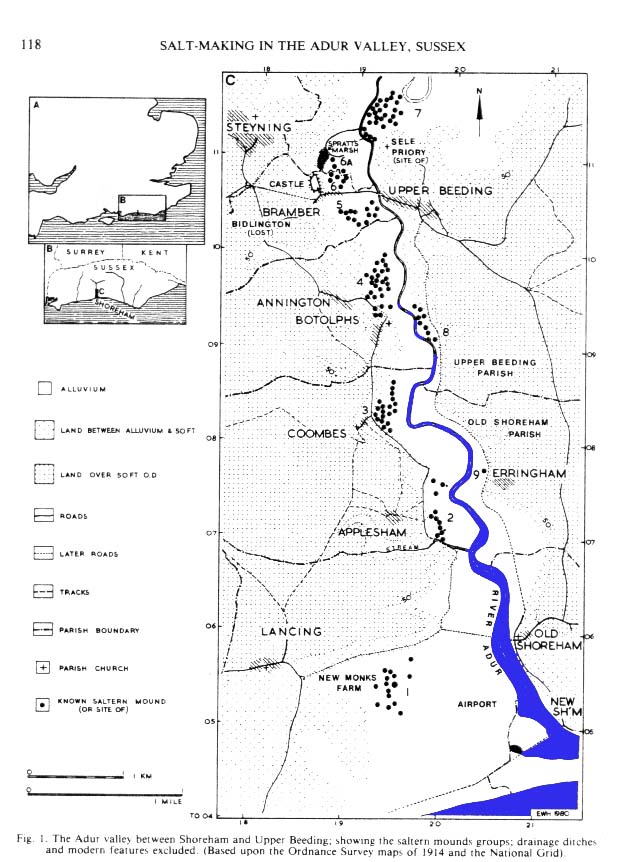SALT
MAKING IN THE ADUR VALLEY
Ref:
In Holden & Hudson's 1981 article on Salt-making in the Adur Valley,
Sussex,
(Sussex
Archaeological Collections 119

cf. Reconstructed map of the Adur Valley
in Medieval times
History of Shoreham (Salt Works)
c.
950 Salt Works
New Monks Farm, Lancing is
the location of a Saxo-Norman salt works. The oldest chert from Britain
proven to have been used for boiling brine was found here. Saltern Mounds
have also been discovered on this site, Lancing. (This area is also known
as Mash Barn.)
Salt-making occurred from
Saxon times until the 14th century all up the lower Adur Valley, including
New Monks Farm at Lancing, Applesham, Coombes, Annington & Botolphs,
Upper Beeding, Bramber, Spratt's Marsh and Sele.
"An
excavation by Con Ainsworth c.1971 of a ploughed-out saltern
mound, one of a large group, found Saxo-Norman pottery but also "one rim
and a joining body sherd....of Portchester Ware, dating to the tenth century.
A scale-like deposit found on one sherd was analysed by D Shelverton and
found to contain substances demonstrating that the pottery vessel had been
used for boiling concentrated brine."
There
is also evidence found of a Post Hole and a Hearth.
<http://www.rchme.gov.uk/nmr.html>
First
Internet Source (located by Ray
Hamblett)
Report on the Adur
Valley eForum
Ray
Hamblett's Web Page
Salt
Works File (notes)
A new record has been added to the database table 'Adur Valley Book
List'.
Title : Sussex Archaeological Collections Vol. 138
(2000)
Author : Sussex Archaeological Society
Publisher : Sussex Archaeological Society
ISBN : 0143-8204 (ISSN)
Comments : Includes "A medieval saltern found at Bramber"
Pub. date and edition : 2001
Added by (name or email) : Andy Horton
'Meet the Ancestors' on BBC2 (23 January
2001) showed a practical demonstration from Bourton-on-the Water, Glos.,
of how brine was put into a clay pot and boiled off to reveal the crystaline
salt.
Regards
Ray Hamblett
EMail:ray.hamblett1@ntlworld.com
Also of interest may be Mark Gardiner's own
trial excavation in the 1990's of
newly-discovered standing earthworks of saltern mounds In Upper Beeding
and
Pre-Construct Archaeology's excavation of a medieval saltern mound
at
Millfields, Bramber- several phases of occupation (report submitted
to SAC).
Copies of interim reports on both sites are in the WSCC SMR. Earlier
in the
1990s, a trial excavation of a recorded saltern mound at Coombes yielded
rather
disappointing results.
John Mills
Please respond to sussexpast@egroups.com
To: "INTERNET:sussexpast@egroups.com" <sussexpast@egroups.com>
cc: (bcc: John Mills/PL/WSCC)
Subject: [sussexpast] Salt-working
An evaluation carried out by Archaeology South-East
at New Monks Farm uncovered evidence of salt-working activity associated
with two partially surviving mounds (both with make-up in situ to a height
of 300mm despite extensive plough truncation). Pottery dated the use of
one of them to the 12th -14th centuries.
Published in Medieval Archaeology Volume
XLVI (2002) p.210
Information also available at WSCC Planning
Department (Archaeology Section)
Simon Stevens
